Market View Report: Analysis of USD/JPY Exchange Rate Trends
VerifiedAdded on 2023/01/19
|5
|1069
|73
Report
AI Summary
This report provides an analysis of the USD/JPY exchange rate, examining the economic factors that influence its value. It identifies key factors such as inflation, government debt, terms of trade, and recession, and how they impact currency valuation. The report analyzes historical exchange rate data between USD and JPY, from September 2019, to identify trends and patterns. The analysis indicates an appreciation of USD compared to JPY during the observed period. The report also forecasts the future direction of the exchange rate, predicting a continued decline in the value of JPY over the next 3-6 months, due to factors like Japan's reliance on oil imports and the impact of stock market movements. The report concludes by referencing relevant academic sources to support its findings.
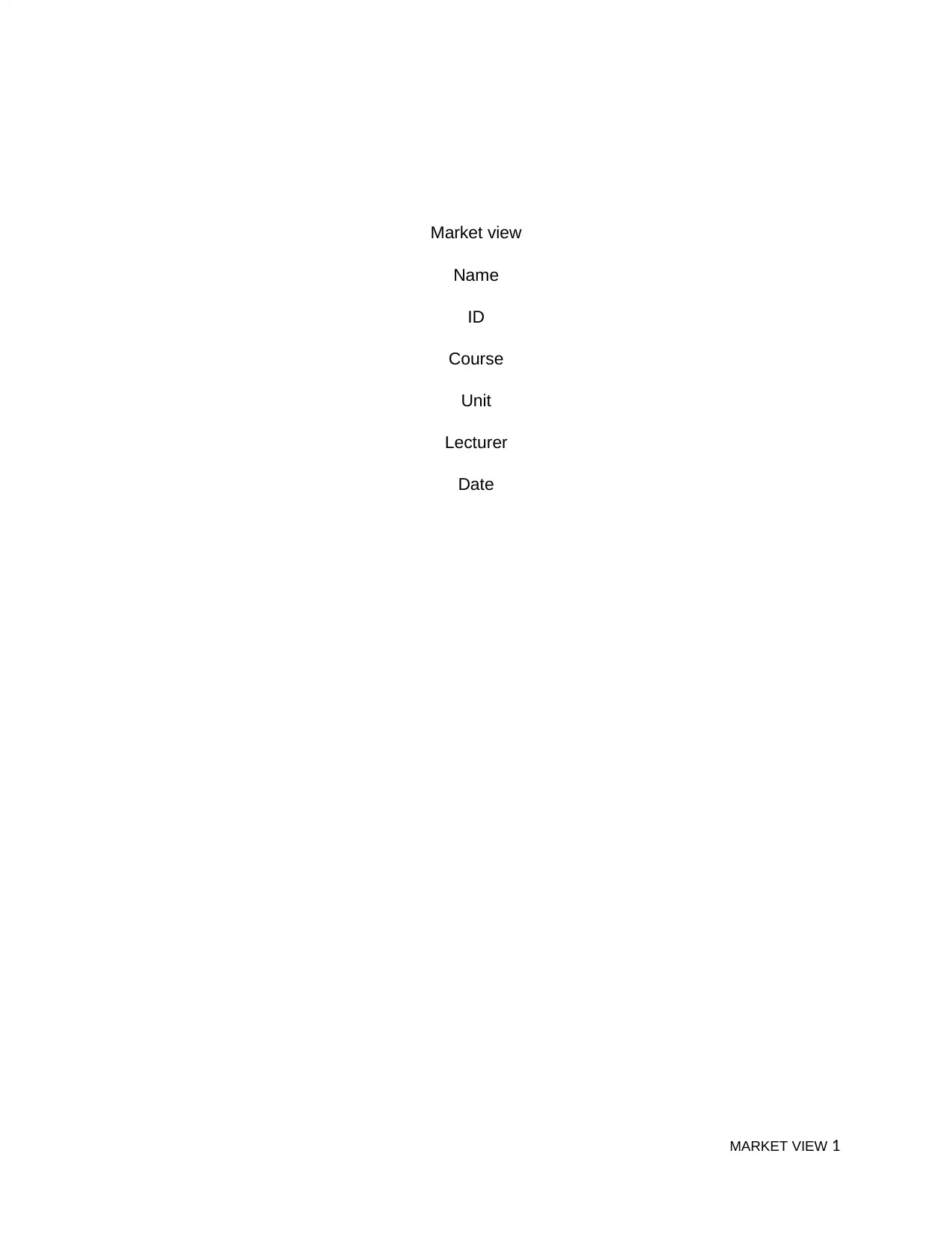
Market view
Name
ID
Course
Unit
Lecturer
Date
MARKET VIEW 1
Name
ID
Course
Unit
Lecturer
Date
MARKET VIEW 1
Paraphrase This Document
Need a fresh take? Get an instant paraphrase of this document with our AI Paraphraser
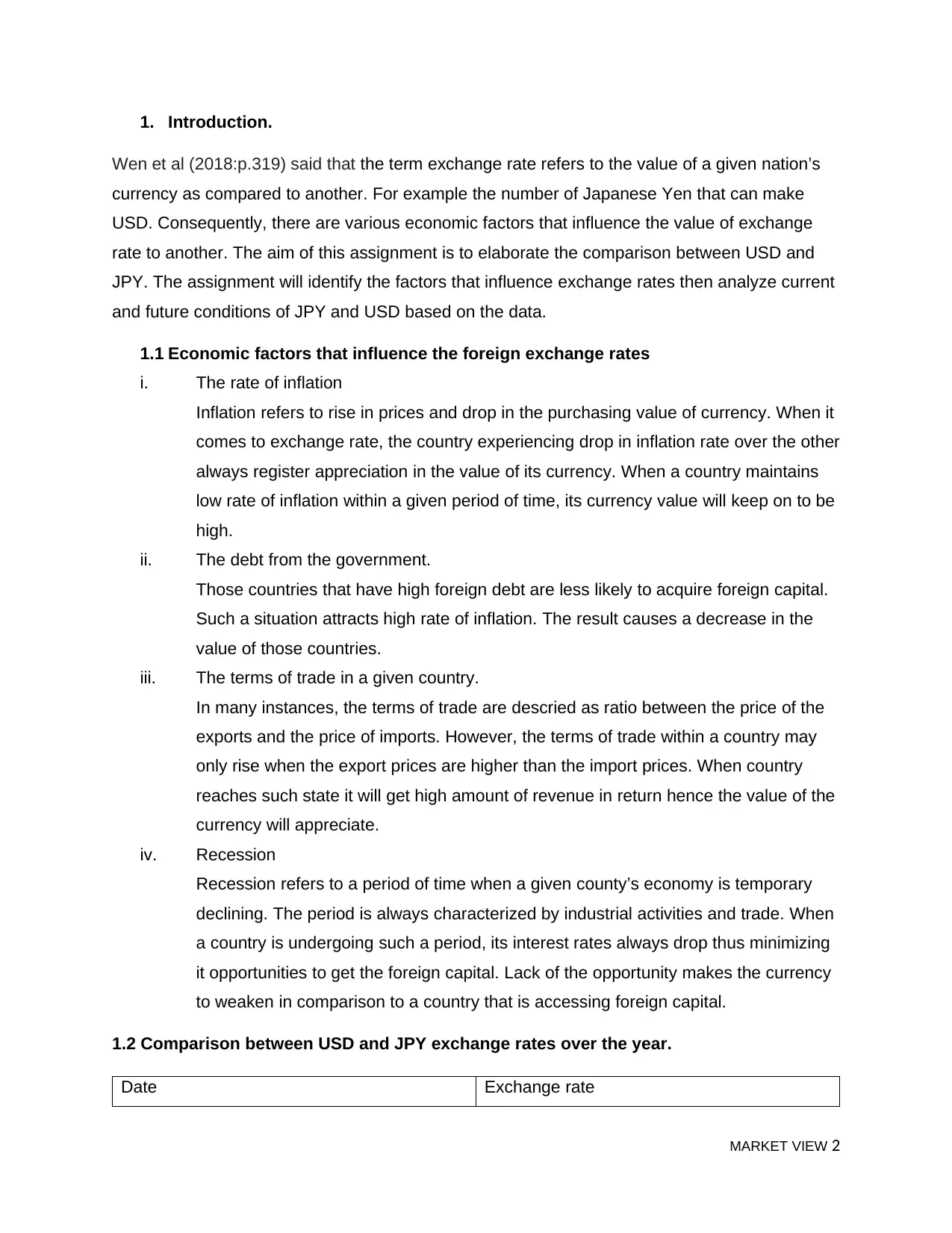
1. Introduction.
Wen et al (2018:p.319) said that the term exchange rate refers to the value of a given nation’s
currency as compared to another. For example the number of Japanese Yen that can make
USD. Consequently, there are various economic factors that influence the value of exchange
rate to another. The aim of this assignment is to elaborate the comparison between USD and
JPY. The assignment will identify the factors that influence exchange rates then analyze current
and future conditions of JPY and USD based on the data.
1.1 Economic factors that influence the foreign exchange rates
i. The rate of inflation
Inflation refers to rise in prices and drop in the purchasing value of currency. When it
comes to exchange rate, the country experiencing drop in inflation rate over the other
always register appreciation in the value of its currency. When a country maintains
low rate of inflation within a given period of time, its currency value will keep on to be
high.
ii. The debt from the government.
Those countries that have high foreign debt are less likely to acquire foreign capital.
Such a situation attracts high rate of inflation. The result causes a decrease in the
value of those countries.
iii. The terms of trade in a given country.
In many instances, the terms of trade are descried as ratio between the price of the
exports and the price of imports. However, the terms of trade within a country may
only rise when the export prices are higher than the import prices. When country
reaches such state it will get high amount of revenue in return hence the value of the
currency will appreciate.
iv. Recession
Recession refers to a period of time when a given county’s economy is temporary
declining. The period is always characterized by industrial activities and trade. When
a country is undergoing such a period, its interest rates always drop thus minimizing
it opportunities to get the foreign capital. Lack of the opportunity makes the currency
to weaken in comparison to a country that is accessing foreign capital.
1.2 Comparison between USD and JPY exchange rates over the year.
Date Exchange rate
MARKET VIEW 2
Wen et al (2018:p.319) said that the term exchange rate refers to the value of a given nation’s
currency as compared to another. For example the number of Japanese Yen that can make
USD. Consequently, there are various economic factors that influence the value of exchange
rate to another. The aim of this assignment is to elaborate the comparison between USD and
JPY. The assignment will identify the factors that influence exchange rates then analyze current
and future conditions of JPY and USD based on the data.
1.1 Economic factors that influence the foreign exchange rates
i. The rate of inflation
Inflation refers to rise in prices and drop in the purchasing value of currency. When it
comes to exchange rate, the country experiencing drop in inflation rate over the other
always register appreciation in the value of its currency. When a country maintains
low rate of inflation within a given period of time, its currency value will keep on to be
high.
ii. The debt from the government.
Those countries that have high foreign debt are less likely to acquire foreign capital.
Such a situation attracts high rate of inflation. The result causes a decrease in the
value of those countries.
iii. The terms of trade in a given country.
In many instances, the terms of trade are descried as ratio between the price of the
exports and the price of imports. However, the terms of trade within a country may
only rise when the export prices are higher than the import prices. When country
reaches such state it will get high amount of revenue in return hence the value of the
currency will appreciate.
iv. Recession
Recession refers to a period of time when a given county’s economy is temporary
declining. The period is always characterized by industrial activities and trade. When
a country is undergoing such a period, its interest rates always drop thus minimizing
it opportunities to get the foreign capital. Lack of the opportunity makes the currency
to weaken in comparison to a country that is accessing foreign capital.
1.2 Comparison between USD and JPY exchange rates over the year.
Date Exchange rate
MARKET VIEW 2
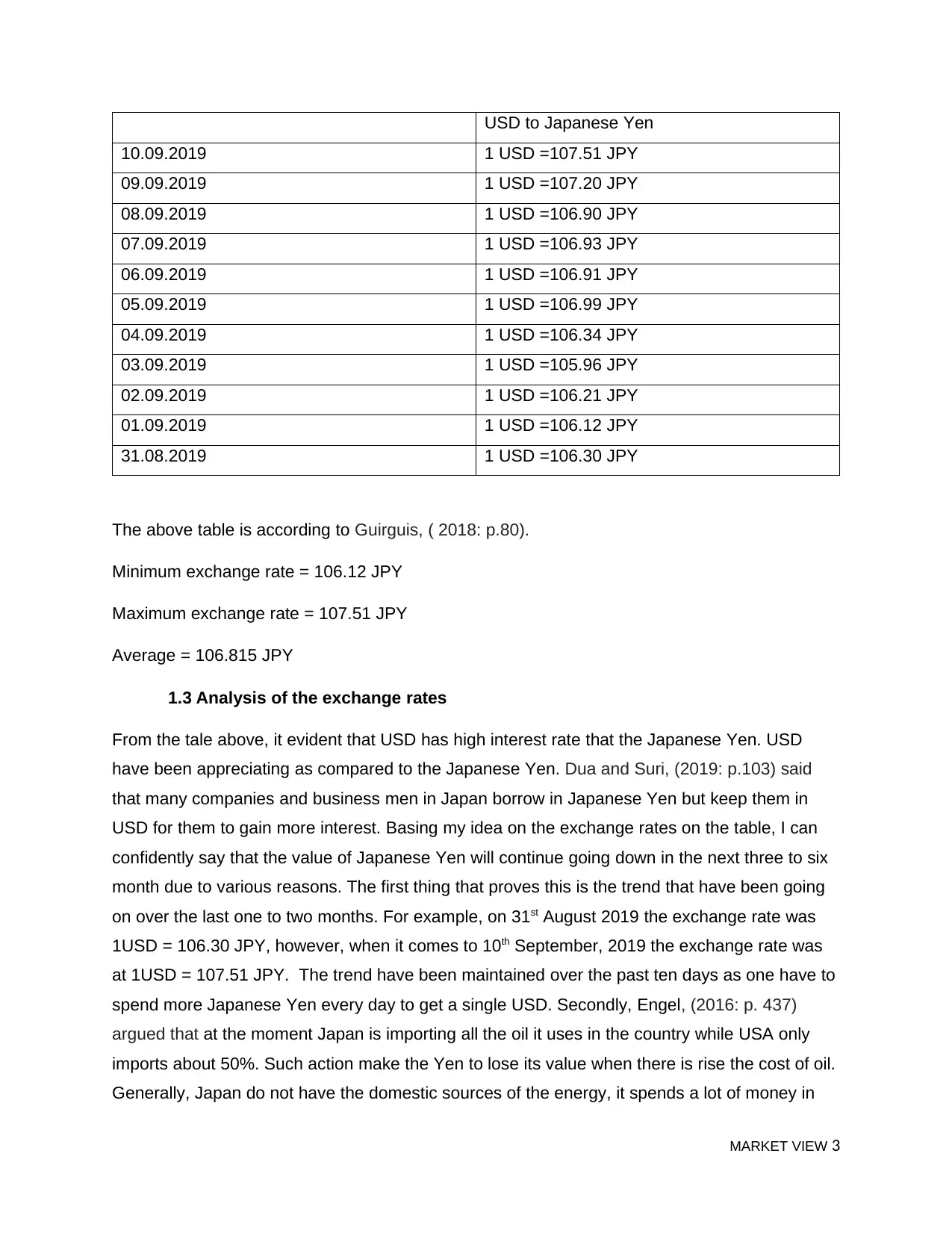
USD to Japanese Yen
10.09.2019 1 USD =107.51 JPY
09.09.2019 1 USD =107.20 JPY
08.09.2019 1 USD =106.90 JPY
07.09.2019 1 USD =106.93 JPY
06.09.2019 1 USD =106.91 JPY
05.09.2019 1 USD =106.99 JPY
04.09.2019 1 USD =106.34 JPY
03.09.2019 1 USD =105.96 JPY
02.09.2019 1 USD =106.21 JPY
01.09.2019 1 USD =106.12 JPY
31.08.2019 1 USD =106.30 JPY
The above table is according to Guirguis, ( 2018: p.80).
Minimum exchange rate = 106.12 JPY
Maximum exchange rate = 107.51 JPY
Average = 106.815 JPY
1.3 Analysis of the exchange rates
From the tale above, it evident that USD has high interest rate that the Japanese Yen. USD
have been appreciating as compared to the Japanese Yen. Dua and Suri, (2019: p.103) said
that many companies and business men in Japan borrow in Japanese Yen but keep them in
USD for them to gain more interest. Basing my idea on the exchange rates on the table, I can
confidently say that the value of Japanese Yen will continue going down in the next three to six
month due to various reasons. The first thing that proves this is the trend that have been going
on over the last one to two months. For example, on 31st August 2019 the exchange rate was
1USD = 106.30 JPY, however, when it comes to 10th September, 2019 the exchange rate was
at 1USD = 107.51 JPY. The trend have been maintained over the past ten days as one have to
spend more Japanese Yen every day to get a single USD. Secondly, Engel, (2016: p. 437)
argued that at the moment Japan is importing all the oil it uses in the country while USA only
imports about 50%. Such action make the Yen to lose its value when there is rise the cost of oil.
Generally, Japan do not have the domestic sources of the energy, it spends a lot of money in
MARKET VIEW 3
10.09.2019 1 USD =107.51 JPY
09.09.2019 1 USD =107.20 JPY
08.09.2019 1 USD =106.90 JPY
07.09.2019 1 USD =106.93 JPY
06.09.2019 1 USD =106.91 JPY
05.09.2019 1 USD =106.99 JPY
04.09.2019 1 USD =106.34 JPY
03.09.2019 1 USD =105.96 JPY
02.09.2019 1 USD =106.21 JPY
01.09.2019 1 USD =106.12 JPY
31.08.2019 1 USD =106.30 JPY
The above table is according to Guirguis, ( 2018: p.80).
Minimum exchange rate = 106.12 JPY
Maximum exchange rate = 107.51 JPY
Average = 106.815 JPY
1.3 Analysis of the exchange rates
From the tale above, it evident that USD has high interest rate that the Japanese Yen. USD
have been appreciating as compared to the Japanese Yen. Dua and Suri, (2019: p.103) said
that many companies and business men in Japan borrow in Japanese Yen but keep them in
USD for them to gain more interest. Basing my idea on the exchange rates on the table, I can
confidently say that the value of Japanese Yen will continue going down in the next three to six
month due to various reasons. The first thing that proves this is the trend that have been going
on over the last one to two months. For example, on 31st August 2019 the exchange rate was
1USD = 106.30 JPY, however, when it comes to 10th September, 2019 the exchange rate was
at 1USD = 107.51 JPY. The trend have been maintained over the past ten days as one have to
spend more Japanese Yen every day to get a single USD. Secondly, Engel, (2016: p. 437)
argued that at the moment Japan is importing all the oil it uses in the country while USA only
imports about 50%. Such action make the Yen to lose its value when there is rise the cost of oil.
Generally, Japan do not have the domestic sources of the energy, it spends a lot of money in
MARKET VIEW 3
⊘ This is a preview!⊘
Do you want full access?
Subscribe today to unlock all pages.

Trusted by 1+ million students worldwide
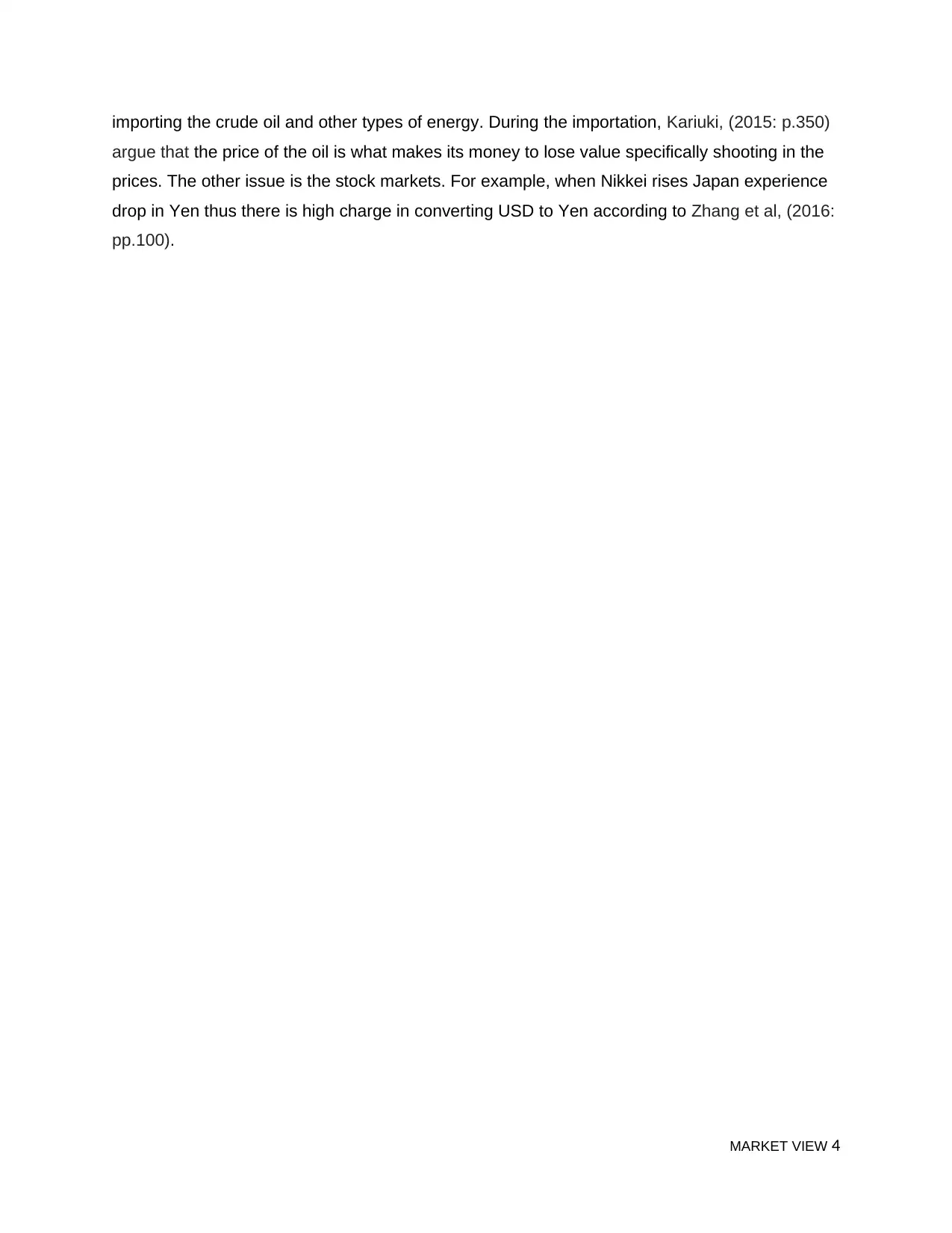
importing the crude oil and other types of energy. During the importation, Kariuki, (2015: p.350)
argue that the price of the oil is what makes its money to lose value specifically shooting in the
prices. The other issue is the stock markets. For example, when Nikkei rises Japan experience
drop in Yen thus there is high charge in converting USD to Yen according to Zhang et al, (2016:
pp.100).
MARKET VIEW 4
argue that the price of the oil is what makes its money to lose value specifically shooting in the
prices. The other issue is the stock markets. For example, when Nikkei rises Japan experience
drop in Yen thus there is high charge in converting USD to Yen according to Zhang et al, (2016:
pp.100).
MARKET VIEW 4
Paraphrase This Document
Need a fresh take? Get an instant paraphrase of this document with our AI Paraphraser
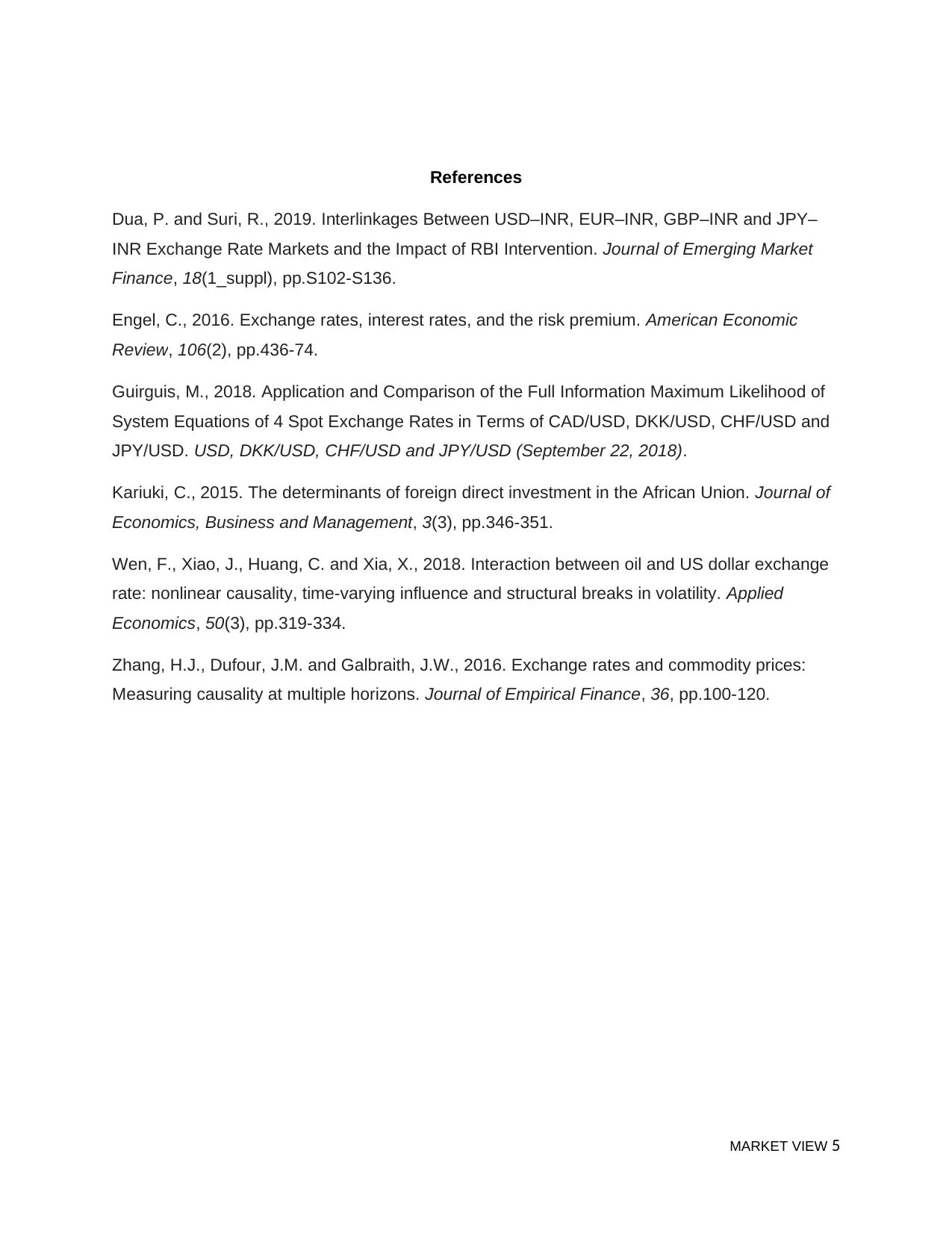
References
Dua, P. and Suri, R., 2019. Interlinkages Between USD–INR, EUR–INR, GBP–INR and JPY–
INR Exchange Rate Markets and the Impact of RBI Intervention. Journal of Emerging Market
Finance, 18(1_suppl), pp.S102-S136.
Engel, C., 2016. Exchange rates, interest rates, and the risk premium. American Economic
Review, 106(2), pp.436-74.
Guirguis, M., 2018. Application and Comparison of the Full Information Maximum Likelihood of
System Equations of 4 Spot Exchange Rates in Terms of CAD/USD, DKK/USD, CHF/USD and
JPY/USD. USD, DKK/USD, CHF/USD and JPY/USD (September 22, 2018).
Kariuki, C., 2015. The determinants of foreign direct investment in the African Union. Journal of
Economics, Business and Management, 3(3), pp.346-351.
Wen, F., Xiao, J., Huang, C. and Xia, X., 2018. Interaction between oil and US dollar exchange
rate: nonlinear causality, time-varying influence and structural breaks in volatility. Applied
Economics, 50(3), pp.319-334.
Zhang, H.J., Dufour, J.M. and Galbraith, J.W., 2016. Exchange rates and commodity prices:
Measuring causality at multiple horizons. Journal of Empirical Finance, 36, pp.100-120.
MARKET VIEW 5
Dua, P. and Suri, R., 2019. Interlinkages Between USD–INR, EUR–INR, GBP–INR and JPY–
INR Exchange Rate Markets and the Impact of RBI Intervention. Journal of Emerging Market
Finance, 18(1_suppl), pp.S102-S136.
Engel, C., 2016. Exchange rates, interest rates, and the risk premium. American Economic
Review, 106(2), pp.436-74.
Guirguis, M., 2018. Application and Comparison of the Full Information Maximum Likelihood of
System Equations of 4 Spot Exchange Rates in Terms of CAD/USD, DKK/USD, CHF/USD and
JPY/USD. USD, DKK/USD, CHF/USD and JPY/USD (September 22, 2018).
Kariuki, C., 2015. The determinants of foreign direct investment in the African Union. Journal of
Economics, Business and Management, 3(3), pp.346-351.
Wen, F., Xiao, J., Huang, C. and Xia, X., 2018. Interaction between oil and US dollar exchange
rate: nonlinear causality, time-varying influence and structural breaks in volatility. Applied
Economics, 50(3), pp.319-334.
Zhang, H.J., Dufour, J.M. and Galbraith, J.W., 2016. Exchange rates and commodity prices:
Measuring causality at multiple horizons. Journal of Empirical Finance, 36, pp.100-120.
MARKET VIEW 5
1 out of 5
Related Documents
Your All-in-One AI-Powered Toolkit for Academic Success.
+13062052269
info@desklib.com
Available 24*7 on WhatsApp / Email
![[object Object]](/_next/static/media/star-bottom.7253800d.svg)
Unlock your academic potential
Copyright © 2020–2025 A2Z Services. All Rights Reserved. Developed and managed by ZUCOL.





